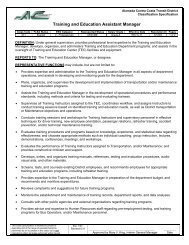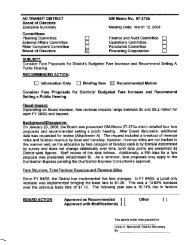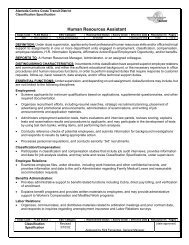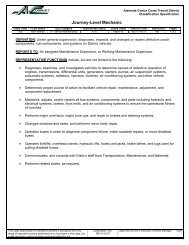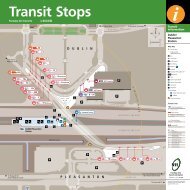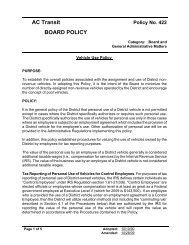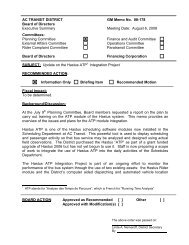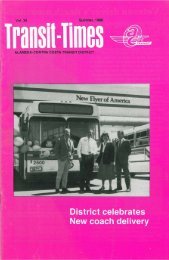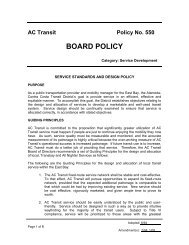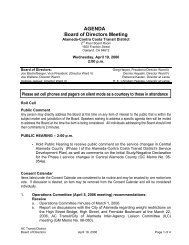GM Memo No. 07-277 - AC Transit
GM Memo No. 07-277 - AC Transit
GM Memo No. 07-277 - AC Transit
You also want an ePaper? Increase the reach of your titles
YUMPU automatically turns print PDFs into web optimized ePapers that Google loves.
<strong>GM</strong> <strong>Memo</strong> <strong>No</strong>. <strong>07</strong>-<strong>277</strong><br />
Subject: Report on Status of SATCOM system<br />
Date: <strong>No</strong>vember 14, 20<strong>07</strong><br />
Page 3 of 6<br />
<br />
<br />
<br />
<br />
<br />
<br />
incidents and accidents<br />
security-related events<br />
outlates, service cancellations, and delays of service<br />
detours<br />
extra service<br />
roadcalls<br />
This information is used by the relevant District departments to track information they<br />
need. For years, the Maintenance Department relies heavily on the roadcall<br />
information, and uses it to monitor miles between roadcalls at each division and Districtwide,<br />
as well as to monitor trends in the type of roadcalls.<br />
Route and Schedule Adherence Information: The District’s scheduling information from<br />
the HASTUS scheduling system is linked to the SATCOM system to provide information<br />
on route and schedule adherence. In fact, the District and Orbital had a cost-sharing<br />
agreement to procure the HASTUS system, because the previous scheduling system<br />
was not compatible with the Orbital system. The schedule and route adherence<br />
information is used on a real-time basis at Central Dispatch, and historical information<br />
is used to develop more accurate schedules for routes. The District’s consultant, TMD,<br />
used the SATCOM data extensively in developing new schedules for many routes in the<br />
past few years that better matched actual running times. In most cases, this has<br />
resulted in adding time to schedules that consistently ran late. This data has proven to<br />
be an invaluable tool in developing better schedules.<br />
Advanced Functions and Applications to Other Systems: The Orbital system is at the<br />
core of other functions and systems that will further enhance system reliability and<br />
efficiency, as well as customer services. Already, the District has implemented<br />
Automatic Vehicle Announcements (AVA) on the 1, 1R, 72, 72R, and 51 lines. Two<br />
new routes will be added soon: the 57 and 40 lines. After that, the District will continue<br />
rolling out the AVA on the remainder of the trunk routes, followed by the rest of the<br />
lines. These automatic announcements free up the operators from having to orally<br />
announce the stops and are also beneficial to the customers. Additional funding was<br />
budgeted over the next two years to roll out AVA on all of the District’s routes.<br />
The Orbital data is also used currently with the NextBus system to predict bus arrivals.<br />
A detailed report on the status of the NextBus system will be provided to the Operations<br />
Committee next month, as will a report on the potential use of Orbital Automatic<br />
Passenger Counters.<br />
Challenges of the System: Although the District is successfully using the SATCOM<br />
radio function and other high priority functions of the Orbital system, staff realizes that<br />
the District is not using the system to its highest potential. One example of the<br />
challenges that the District faces with the system has to do with operator log-ons. To




